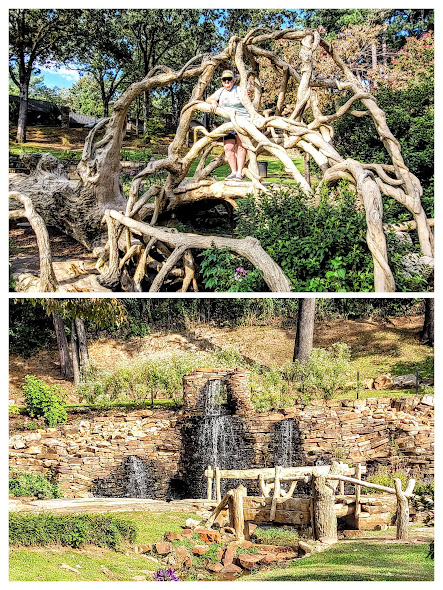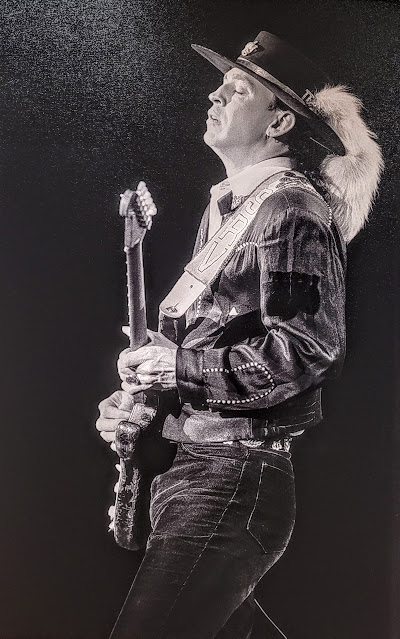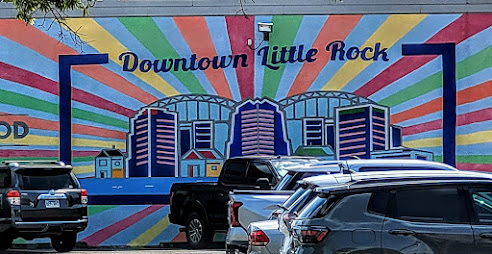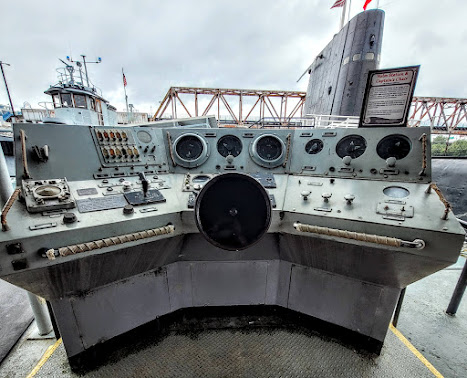The funny thought about visiting this garden, we were only about four blocks away from it after leaving the Arkansas History Museum. Our four blocks turned into about a mile and a half by the time we got there.
The downtown area uses an electric trolley system, which meant tracks of course. During our walk an unfortunate cyclist took a spill in the road when he hit the tracks at the wrong angle... no he did not get run over by any cars, and managed to walk away. This occurred as we were leaving the garden, we were across the street.
Time to head back to the truck parked at the Arkansas History Museum, and back home. It was a great day out.
IF YOU THOUGHT IT WAS OVER... WRONG, I'M LONG WINDED ON THIS POST.
I bet you thought we were done with the civil rights movement, but that wasn't true. Little Rock was the hot bed for desegregation in 1957. The governor said it wasn't going to happen, the president said it was... and it did.
Where did it begin... Little Rock Central High School, and nine negro students that volunteered to attend the school.
The nine black students were ushered up those steps by U.S. military soldiers. The soldiers could only walk into the school, they had to stay out of the classrooms and lunchroom, and auditorium.
LOOKING FROM THE MAIN ENTRANCE
Our Constitution written in 1787 did not mean all people were considered equal, it wasn't until 1808 that Congress prohibited importing slaves. Article 1, section 9 states:
SECTION 9. The migration or importation of
such persons as any of the states now existing
shall think proper to admit, shall not be
prohibited by the Congress prior to the year one
thousand eight hundred and eight, but a tax or
duty may be imposed on such importation, not
exceeding ten dollars for each person.
One needs to keep in mind that in the era when the constitution was written, it was the belief that the rich should be the governing power. I could digress on this subject, but I won't for now... I can't do it.
CLASS IS IN SESSION:
Before the Constitution was ratified, it started as the Lee Resolution that was introduced in 1776, then the Articles of Confederation were adopted in 1787, but not ratified until 1789, and called The Constitution of the United States.
State governments were in place before the federal government ever existed. The states had a lot of power in the Articles of Confederation, but some of that power needed to be surrendered to form a stronger federal government. You now see why it took two years to ratify the new "Constitution of the United States".
The states still retained some of their governing powers as seen in the 10th Amendment:
"The powers not delegated to the United States
by the Constitution, nor prohibited by it to the
states, are reserved to the states respectively, or
to the people."
The Naturalization Act of 1790 declared that persons needed to be a reside in the United States for two years... oh yeh, and be a free white person.
In lies the root of civil rights from the very beginning.
Another issue was who could vote. Originally it was only the white male that owned land and could afford to pay taxes. That meant that the ordinary white male could not vote. Extending the opportunity to the other white males didn't occur until after an economic crisis in 1819. As late as 1830 saw only white males voting, and that was only in 10 of the states, 8 only allowed tax payers to vote, and 6 maintained a property requirement.
In 1789 married women had less rights than single, or widowed. Of course one of the restrictions was voting. During that era, it was the husband that had control over most of the aspects the the wife's life. Single women and widows could at least own land in their name and enter into contracts to support themselves... "so they wouldn't be a burden to society". White women finally did get the right to vote in 1920, thanks to the 19th Amendment.
When the Constitution was written, Indians were not considered citizens of the United States, even though they were here first. It wasn't until the Indian Citizenship Act (1924) that Natives American Indians got the right to vote, in national elections.
The Constitution did not distinguish between "free" and "slave" blacks. A young Black man sued for his freedom. In 1857 the Supreme Court came down with the decision that even though he lived in a "free state" he had no standing in the federal courts because of being enslaved or a descendant of slaves... because they were not considered U.S. citizens.
Here is the kicker. Per the Constitution, an enslaved person fell into to the category of "other", and was counted as 3/5th of a person when counting people to determine how many representatives would represent a state. The Emancipation Proclamation of 1863 did little to change their status, except to make them free in the Confederate states. the 13th Amendment abolished slavery on a national level:
Section 1.
Neither slavery nor involuntary servitude, except as a punishment for crime whereof the party
shall have been duly convicted, shall exist within the United States, or any place subject to their
jurisdiction.
One last thought regarding how our Constitution allowed slavery without the word "slave" in it. Remember when I mentioned Article 1, Section 9 of the Constitution. While Congress did prohibit importing slavery in 1808, the government did benefit from slavery importation prior to 1808... there was a tax for each slave imported.
Article 4, Section 2, paragraph 3:
"No person held to service or labor in one state,
under the laws thereof, escaping into another,
shall, in consequence of any law or regulation
therein, be discharged from such service or labor,
but shall be delivered up on claim of the party to
whom such service or labor may be due."
This Article became a bone of contention closer to the Civil War , when the Northern sympathizer didn't make any efforts to return slaves to their owners.
CLASS DISMISSED.
I have already spoke of the Civil Rights movement in an earlier post, so I am going to try and stay on track with the story of the desegregation of Little Rock Central High School.
The nine African-American students that volunteered to attend the all-white school were but a portion of the original volunteers. Many of the other volunteers backed out when they learned they would not be able to fully participate in school activities such as band, student government, sports, or choir.
Remember that the Supreme Court handed down their ruling a few years earlier: "separate but equal".
SEPARATE... BUT NOT EQUAL
These were the two new high schools Little Rock was building in 1955, Horace Mann on the left, Little Rock Central (LRCHS) on the right.
Back to why these nine students decided to go to LRCHS vice Horace Mann. Even though they had great relationships with their teachers and lots of friends, they knew there was a broader education at the "white" school, which would better prepare them for college.
I liked the fire that some of the African-American students had. When asked why she went, her response was:
Carlotta Walls:
"Our parents were paying taxes just like the white parents, but we were still getting the short end of the stick."
Gloria Ray's comment:
"I knew about Central High. It was one of the two-hundred best schools in the United States. Not that the teachers were any better... but they had more funds, more facilities, and more resources."
Melba Pattillo said:
"When I was at Mann, every year we'd get this stuff shipped in from Central High and other white schools. There would be three-legged tables, typewriters with keys missing, and smeary books. And we were supposed to be grateful for this stuff?"
This is only my opinion of the Governor of Arkansas, Orval Eugene Faubus... he was a jerk, I'm keeping it nice.
The night before the integration, he called up the Arkansas National Guard to prevent the students from entering the school; his reasoning... to prevent any violence.
The Mayor, Woodrow Mann, no relation to Horace Mann, was a man about change, taking on corruption in the city government, integrating the city transportation, and doubling African-American police officers to the force, that went from two officer to four officers. The point was that he wanted to see change. Unfortunately the city voted to go to a "city management" style government, reducing his powers as mayor.
Eisenhower had pledged in his campaign to end discrimination, and that is what he did when he entered office. He desegregated D.C. transportation, addressed discrimination in federal hiring by hiring an African-American man on his staff, and established an office of civil rights in the White House.
So, how did he address the Governor's attitude... he sent in the 101st Airborne to protect the student, and the Federal Government's authority to uphold the Constitution.
Because of groups like this...
SEGREGATIONIST MOTHERS' LEAGUE
... The African-American students didn't go to school the first day. The second day wasn't much better...
ARKANSAS NATIONAL GUARD
... The guardsmen denied them access to the school.
Because of the ongoing threats of violence, the students stayed home on day five, September 5th, and would stay home for the following two weeks.
Here was President Eisenhower's response to a telegram from Governor Faubus:
The two met in Rhode Island, where the president was hoping to come to some resolution. After the meeting Eisenhower believed that Faubus would "observe the supreme law of the land", and obey the court order. Faubus came back home and did just the opposite.
The following days between September 20th and 24th saw a changing of the guard, violence, and changing of the guard again. Before the National Guard left, they were federalized by President Eisenhower.
ARKANSAS NATIONAL HEAD HOME
VIOLENCE BEGINS
When the National Guard left, Little Rock police were were now responsible for protecting the students. When a crowd learned that the students had gotten in the school, the crowd grew to over a 1,000 people, and the violence began. The police had to sneak the students out a basement exit.
FEDERAL TROOPS MOBILIZED
The 101st Airborne were now responsible for the students. Eisenhower was hoping that states would obey federal law as given by the Constitution, but that was not to be.
When the students were finally escorted into the school by the 101st, the media stuck cameras and microphones in the student's faces trying to get interviews. The mob outside the school started beating on bystanders with bats and bricks.
These cards were given to the white students. The top allowing whites to hurt the African-American students, the second pertains to a white teacher who was also the assistant principle and girls counselor, and the last pertained to the fact that one of the African-American students who was expelled for defending herself in the lunchroom.
By October 10th, the 101st returned home, and were replaced by the "federalized" National Guard. The nine endured a lot during the school year, with the segregationist whites calling them names, kicking them, tripping them, and offering up other violent insults. Bomb threat and fire drills became a routine event.
I did like the attitude of Ernest Greene, the first African-American to graduate from LRCHS.
"The harder they fought to keep me out, the more determined I was to finish and get my diploma."
They encouraged him not to work for fear of violence, but his courage was greater than theirs, he walked and received his diploma.
GRADUATION DAY
Remember I thought Governor Faubus was a jerk...
"THE LOST YEAR"
(The federal didn't order it.)
Faubus was not about to have integration, and closed all four high schools for the 1958-1959 school year. He accomplished that thanks to a newly-passed state law that was passed that gave him authority to close down any school "being integrated by force". In a referendum, 3/4s of the Little Rock residents voted to support Faubus' decision.
During that same year, the segregationist school board attempted to fire all the teachers and administrators suspected of supporting desegregation. In a special election the voters removed the segregationist board members, this paved the way for the school board to reopen the schools and continue desegregation.
What I found interesting between the last two paragraphs, there must have been a significant event to happen to get a good share of the 3/4s of the residents to vote out the segregationists on the school board. Miracles can happen.
AMERICA CARES
The artist, Georg Hunts depicted the Little Rock Nine flanked by a soldier on the left, symbolizing the defense of every citizen's rights, and an adult supporter on the right, representing leadership. This painting was commissioned to celebrate the 40th anniversary of the events at Central High. For several years it hung in the White House during Clinton's time in office. In 2005, it was made into a postage stamp.
Later the Little Rock Nine would receive a gold medal for courage from Congress.
Visit the website at: https: //www.nps.gov/chsc.
ITS COFFEE BREAK TIME, BUT WE ARE ALMOST HOME.
Here we go into the home stretch.
On our walk from the Clinton Library and Museum I thought I saw a submarine near the park... sure 'nough, it was moored a short distance from the park.
One day I was out getting gas in preps for departure, and I stopped in to see if it was open, seeing as how it was the weekend... yep, it was open. I called Carol to see if she would like to tour the boat, she declined, and off I went.
The museum is actually a two-for-one deal, the submarine, and a yard tug. The submarine is a guided tour, the tug visitors can do on their own.
This is not part of a submarine, but it brought back memories of all the equipment my job was responsible for on the helm, and that would have been everything but the helm wheel.
You would notice that the submarine flies two flags, U.S., and Turkey. When the U.S. Navy was done with the submarine, it was sold it to the Turkish Navy in the 1970's, and they sailed it until 2000, making it the longest commissioned submarine. The boat was commissioned in 1944 by the U.S., and decommissioned by the Turks in 2000, giving her almost 60 years in service. The submarine was slated to be scrapped in 2002, and an alumni sailor heard about it and got funds up to buy it back from Turkey, and get it back home.
This boat is not set up for tours like many of the others we visited, and yes, Carol would have had an issue with the ladders in and out of the submarine, they were vertical, I almost had issues with them.
Anyway, we started the tour in the aft torpedo room, and as usual, this is also one of the berthing spaces for the crew.
From the torpedo room we passed old switching gear and into the galley/crew mess.OLDY SWITCH GEAR
GALLEY
The mess only seated about 15 sailors, so there was no time to really socializing when it came to feeding a hundred-man crew; it was kind of like boot camp, wolf it down and move on. The sailor in the photograph was their cook, and still is their cook. Whenever the old crew reunites, he cooks up the dinner.
If you have never been on a submarine you probably have no idea how they store all their staples... easy, anywhere it will fit.
You are looking at a grate in the deck (floor) that has access to the refrigerated staples. One joy the submariners had that is not an option... an ice cream maker. This day the ice cream machine was replaced with a refrigerator.
A little further down the p-way we passed by the admin office, wardroom and mini-galley, and officer staterooms, with the next stop being navigation.UP TO THE CONNING TOWER
IN THE DRIVER SEATS
Unlike the newer boats, the steering was on one side of the submarine. This boat had enlisted berthing, two engine rooms, and a forward torpedo room, which was our exiting point.
You may have heard the term hot-racking, which was common on submarines. What it means is one guy climbs out of the rack so another can climb in. Anybody getting the heebie-jeebies about that. If you haven't yet, let's continue on. The old days of submarines had limited fresh water making abilities at a 1,000 gallons a day from salt water. No problem, right... wrong when you consider what required water. The engines were water cooled, and water was needed for cooking. With these water demands, it meant that showers were rare, almost to the point of only one shower per person during the entire cruise. Now, you ready to climb in that rack? Got the heebie-jeebies now?
After I left the submarine I headed over to the tug.
USS HOGA, YT-146
(Sioux word meaning "fish")
This tug saw duty in Pearl Harbor, and was a major factor in events on the day of 9 December.
The tug was moored with the other tugs near the shipyard when the bombing began. Within 10 minutes of the first strike the Hoga was given orders to help in any way possible.
Her first job was pulling a repair ship, the USS Vestal, AR-4 away from the Arizona, BB-39, which was ingulfed in flames. From the Vestal, they headed over to help a minelayer, USS Oglala, CM-4, flagship for Rear Admiral Furlong. While helping the Oglala the USS Nevada, BB-36, having sustained a torpedo hit and was able to counterflood so she didn't capsize, passed them steaming for open sea.
With the Nevada heading for open water, the Japanese saw an opportunity to achieve two goals, sink a battleship, and close the channel, so they concentrated their efforts on her. Sustaining many hits and sinking, she attempted to get out of the channel. Rear Admiral Furlong saw the Nevada severally heave and directed the two tugs assisting his ship to go help the Nevada.
The Hoga tied to the bow of the Nevada, and she, and the second tug pulled the sinking Nevada to Hospital Point, out of the channel. The Hoga continued to fight forward fires on the ship for over an hour.
Returning back to Battleship Row she fought fires on the Arizona from 1600 (4pm) Sunday to 1300 (1pm) Tuesday.
After the attack the Hoga gained other duties like watching for possible Japanese submarines in the harbor, cleaning debris from the harbor, and salvage operations. Later the tug was redesignated to a YTB (large). In 1948 the Hoga was transferred on loan to the Port of Oakland for use as a fireboat.
I climbed back in the truck and drove the entire 3/10th of a mile back to the park. Yes, I did continue to get ready to travel, so we'll see you later.
MISC. EVENING PHOTOS OF THE NIGHT LIGHTS.
WALKING BRIDGE AT NIGHT


















































































































































